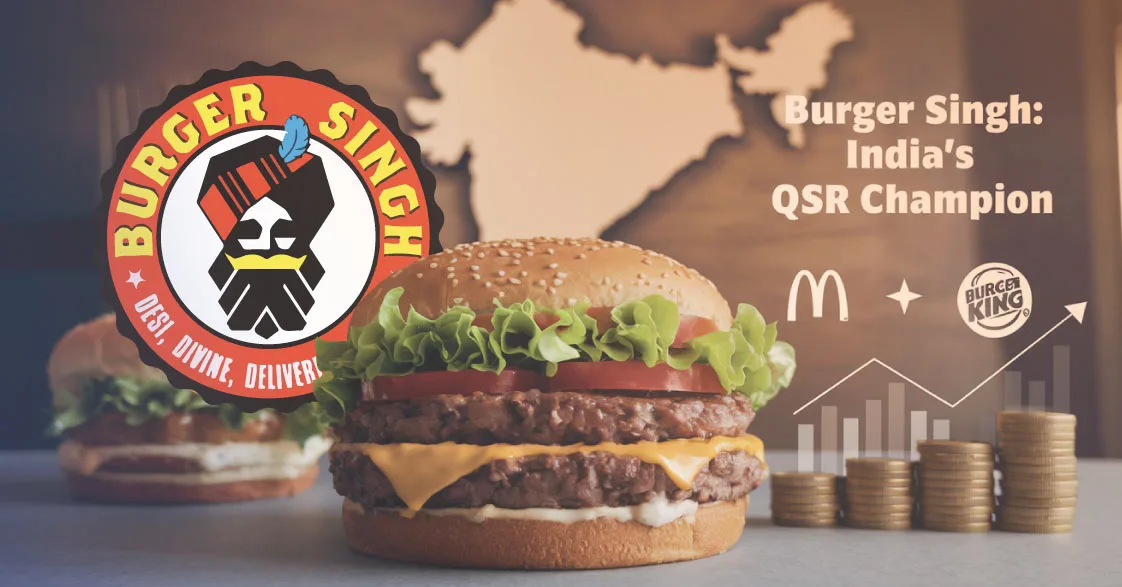Burger Singh’s Remarkable Growth: The Indian QSR Giant Taking on McDonald's and Burger King

McDonald's and Burger King are massive players, with both companies being 22 times the size of Burger Singh. Yet, Burger Singh is on track to steal a significant share of the Indian fast-food market.
India's Quick Service Restaurant (QSR) sector has immense growth potential compared to countries like the United States and China. India has just 3 QSR stores per million people, while China boasts 13 QSR outlets per million. This highlights that India is still under-penetrated, creating a prime opportunity for innovative brands like Burger Singh to disrupt the market.
In just a decade, Burger Singh has emerged as India's largest domestic burger chain, with over 175 outlets in 75+ cities. But what makes their success story so impressive? How did they grow rapidly while competing with global giants like McDonald's and Burger King?
The Key Ingredients Behind Burger Singh's Success
1. Unique Desi Flavors in Their Menu
Burgers are already popular in India, but Burger Singh's unique twist sets them apart. Unlike McDonald's and Burger King, Burger Singh offers burgers with an Indian flair by infusing local flavours into their patties and sauces.
Some examples of their Desi-style innovations include:
- Punjabi Paneer Burger
- Amritsari Murgh Makhani Burger
- Bhuna Mutton Burger
This Indian fusion makes their menu stand out from the typical offerings, resonating well with local tastes. They've embraced India's love for bold, spicy flavours, ensuring that their burgers offer something familiar yet unique.
2. Bigger Burgers for the Same Price
Burger Singh focuses on giving customers more value for their money. While most QSR chains follow standard portions, Burger Singh's burgers are 20% larger than the usual offerings at similar prices. This strategy ensures that customers feel satisfied and full after each meal, encouraging them to return.
By combining value-for-money pricing with larger portions, Burger Singh has appealed to cost-conscious Indian consumers who expect quality and quantity.
3. Penetrating Tier 2 & Tier 3 Cities First
One of Burger Singh's most innovative strategies has been its focus on smaller towns and cities. While many international QSR brands heavily focus on metros like Mumbai, Delhi, and Bengaluru, Burger Singh decided to capture the under-served Tier 2 and Tier 3 markets.
65% of Burger Singh's outlets are located in these smaller cities, where competition is lower and operating costs are more manageable. This "top-down" penetration strategy allowed Burger Singh to gain a first-mover advantage in markets where consumers had fewer QSR options.
This innovative approach gave them a loyal customer base and allowed them to dominate regions that global QSR giants had overlooked.
4. Rapid Revenue Growth
Burger Singh's growth trajectory has been remarkable. The brand saw a 97% increase in revenue in 2023, showcasing the effectiveness of its business strategy branding efforts. With more Indians developing a taste for burgers, Burger Singh is well-positioned to meet this rising demand while continuing to grow aggressively across the country.
How Burger Singh Stands Out Against McDonald's and Burger King
Although McDonald's and Burger King are still giants in the industry, Burger Singh has several competitive advantages:
- Tailored for Indian Palates: By offering Desi-American burgers, Burger Singh delivers a familiar and exciting product to Indian consumers.
- Affordable Pricing: Their value-for-money approach ensures customers get more for less, encouraging repeat purchases.
- Untapped Market Focus: While global chains are busy competing in metro cities, Burger Singh has captured smaller cities and towns' hearts (and appetites).
- Local Roots: As a homegrown brand, Burger Singh appeals to national pride and resonates with consumers looking to support Indian businesses.
A Bright Future for Burger Singh
At the current pace, Burger Singh is set to become a household name across India. With its innovative menu, value pricing, and deep reach into smaller markets, the company is creating a strong foothold in India's QSR landscape.
Burger Singh's journey isn't just about selling burgers; it's about defining what fast food can mean for Indian consumers. As they continue to expand and capture more market share, it's likely that India will soon develop a taste for Desi-American burgers, thanks to this rising star in the QSR world.
While McDonald's and Burger King may still be larger, Burger Singh is steadily carving out its space in the Indian market. If its growth continues at this rate, Burger Singh will soon become a dominant force in the industry, proving that even global giants can be challenged by innovative strategies and local flair.
The next time you crave a burger, why not try Burger Singh? You might discover why this homegrown brand is becoming India's answer to McDonald's and Burger King!

FAQs
Share
Table Of Contents
- The Key Ingredients Behind Burger Singh's Success
- How Burger Singh Stands Out Against McDonald's and Burger King
- A Bright Future for Burger Singh
